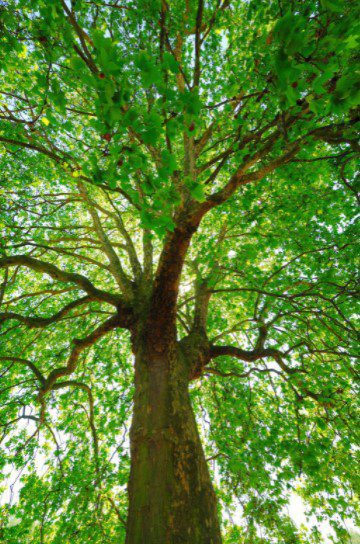Sycamore Tree
The sycamore tree is one of the most prominent trees at this time of the year. Because the magnificent bark is not as visible now, it can be seen from a distance.
The outline is stunning even without leaves. Exfoliating bark is a feature of this massive tree.
This is a term used by botanists to describe bark exfoliated in irregular patterns to expose the underneath.
This is what makes the sycamore tree so worth another look. The massive trunk may be described as having a jigsaw-like design by some.
Some may argue that the bark of the tree appears mottled.
The bark of the sycamore tree is typically a gray-white color at its lower end. As the bark is removed, it becomes a cream color.
Sometimes, the bark of the sycamore trees may be soft brown or even green. It is also remarkable for its branching patterns.
Sycamore Tree Information
Hugh Johnson, a British observer, described it as “a tracery where the weeping branches form countless small Gothic arches.”
Trees are the frosting on nature’s cake. They dominate our landscape in the Midwest and define the changing seasons.
Fall color is starting to appear in their leaves at the beginning of the bittersweet autumn season, with its beautiful cool weather and clear, bright skies that also mark the beginning of the end of the gardening season that I love so much.
The fact that trees’ leaves can suddenly go from a homogenous canopy of brilliant green into a dazzling multicolored umbrella, each outdoing the next with its superior performance, lets me down easy.
After contentedly bending over to dig in the dirt all summer, my gaze is drawn upward, always filled with wonder by the performance.
But not every tree wears its choicest finery in the fall. Some are at their best when they are in bloom.
Others are at their most enchanting in the green they wear in the summer, and some flaunt their Sunday best in the form of bright berries that persist on their branches into the winter.
And then there is the sycamore tree, a lumbering giant of a tree that chooses to wait until after leaf drop when woody companions are asleep and dreaming – all shape and dark bark – to wow us.
Suddenly the majestic apparition of the mature sycamore’s towering trunk in its fitted silvery gown appears, exposed when the papery outer layers of brown and gray bark have peeled away.
Sycamore Tree Varieties
The American sycamore tree is the largest of the Eastern indigenous trees, proliferating to 75 to 100 feet. A 1-year-old seedling can easily stretch to 10 feet.
A typical sycamore trunk will attain a 3- to 8-foot diameter, and records show a tree with a 16-foot trunk is not uncommon. Sycamores can live for 500 years or more, though they gradually hollow out in the process.
There are stories of sycamores in Colonial times so large that 15 men on horseback could fit into the hollow trunk. It is also said the trees occasionally served as temporary housing for displaced families during the period.
Though Indiana’s state tree, today’s record, American sycamore, is located in Ashland County, Ohio, it is 129 feet tall, with a trunk that is 48.5 feet in circumference and a crown with a 105-foot diameter.
The world’s largest sycamore stump has been enshrined as a monument at Highland Park in Kokomo, Ind. It is entirely 57 feet in diameter and was nearly 800 years old before it succumbed to a summer storm in 1919.
For many years the stump held a phone booth large enough for a dozen people – the original conference call, I guess.
Sycamores’ big, maple-like leaves are responsible for the tree’s name, coined because of their likeness to the leaves of a Eurasian maple called a sycamore. Its round, golf-ball-size fruits dangle from 5-inch petioles and give the tree its common name of “buttonball tree.”
The fruiting balls eventually release tufted seeds that parachute on the wind, floating to faraway destinations. Juncos, purple finches, goldfinches, and chickadees are all fond of sycamore seeds.
“Shade” could be sycamore’s middle name, though the trees are not exactly a good choice for the average backyard. Sycamores and their hybrids – specifically the London plane-tree cultivar – have been used extensively in parks and boulevard plantings.
Some of the original sycamores planted in New York’s Central Park, designed by Frederick Law Olmsted and Calvert Vaux in 1858, continue to provide shade for park visitors.
In 1971, astronaut Stuart Roosa carried seeds from redwood, sycamore, Douglas fir, and sweetgum trees aboard Apollo 14 on its historic flight to the moon.
The seeds safely orbited the moon 37 times in the command module, only to have the canister that held them explode during decontamination. Still, nearly all the seeds germinated.
In 1976, the “moon trees” were distributed as part of this country’s bicentennial celebration, and one of the sycamores ended up in Walther Park in De Soto.
I’ve considered sycamores to be moon trees long before I knew about Roosa’s experiment, their lustrous bark illuminated by the moon against the dark of winter nights.
And before I know it, the familiar haze of new green will appear in trees’ branches, coloring a full circle of the seasons.
























Comments are closed.